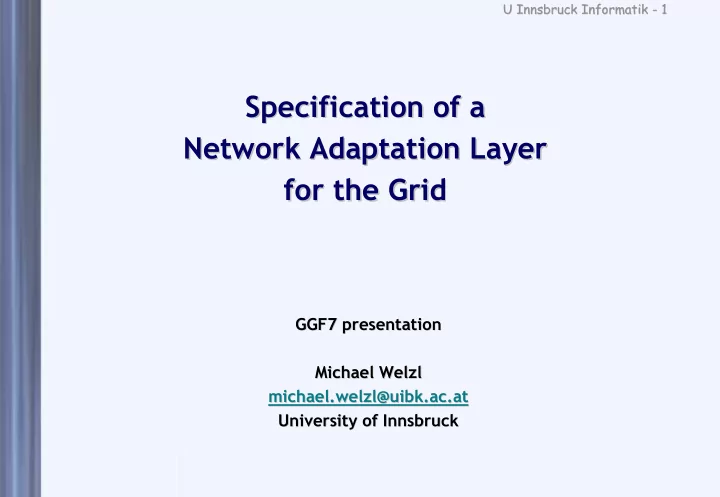

U Innsbruck Informatik - U Innsbruck Informatik - 1 1 Specification of a Specification of a Network Adaptation Layer Network Adaptation Layer for the Grid for the Grid GGF7 presentation GGF7 presentation Michael Welzl Welzl Michael michael.welzl@uibk.ac.at michael.welzl@uibk.ac.at University of Innsbruck of Innsbruck University
U Innsbruck Informatik U Innsbruck Informatik - - 2 2 Outline Outline • Problem statement • Proposed solution – what – why – how • Just 10 mins... no time to conclude ;-)
U Innsbruck Informatik U Innsbruck Informatik - - 3 3 Note: we simplify! Note: we simplify! • Assumption 1: all is done @ end nodes – No dedicated network – No management / control of network resources • Assumption 2: realistic usage of existing Internet technology – No QoS mechanisms like DiffServ or IntServ – No QoS routing, no Active Networks • Assumption 3: a tough one, right? ;-) a single end2end connection! – No overlay structure – No distributed schemes ... no P2P, caching, etc.
U Innsbruck Informatik U Innsbruck Informatik - - 4 4 Current use of the Internet Current use of the Internet • TCP – byte stream from source to destination – reliable, connection oriented service – all kinds of complex features • window based flow and congestion control – RTT estimation, self-clocking, parameters: max. / init. window size,... – slow start / congestion avoidance • flavors: Tahoe, Reno, NewReno, SACK, with and w/o ECN, .. • UDP – connectionless service – ports and a checksum ... that‘s it :) • simpler, but useless for reliable transport (DIY) • What about congestion control?
U Innsbruck Informatik U Innsbruck Informatik - - 5 5 Some (realistic) things we can do... Some (realistic) things we can do... • Alter packet size • Tune TCP parameters – decide which TCP flavor to use, fiddle with window size, .. • Implement rate control on top of UDP • Use new technologies, like... – UDP Lite: transmission of erroneous payload – SCTP: transport level multihoming, reliable out-of-order transmission – DCCP: congestion control for datagrams (connectionless) • Measure and do something... maybe adapt payload...
U Innsbruck Informatik U Innsbruck Informatik - - 6 6 Proposed solution Proposed solution
U Innsbruck Informatik U Innsbruck Informatik - - 7 7 What: an “Adaptation Layer“ an “Adaptation Layer“ What:
U Innsbruck Informatik U Innsbruck Informatik - - 8 8 Why we need it we need it Why • Application relieved of burden – more sophisticated transmission mechanisms possible – tailored network usage instead of “one size fits all“ (just UDP / TCP) • Network provides service - app specifies QoS requirements – Adaptation layer makes the most out of available resources • Adaptation layer provides QoS feedback – Information logically closer to application • Full transparency to application – gradual deployment of new transport mechanisms
U Innsbruck Informatik U Innsbruck Informatik - - 9 9 How it could work: application interface it could work: application interface How • from application – QoS spec • apply weights to QoS parameters • goal: tune trade-offs (packet sizes, ..) • Examples: – reduced delay is more important than high throughput – I don‘t care about a smooth rate (I use large buffers) – Traffic spec • Example: long lasting stream, “greedy“ • to application – “video frame complete“ instead of “throughput = ... loss = ... “, ..
U Innsbruck Informatik - U Innsbruck Informatik - 10 10 How it could work: internals it could work: internals How • Control of network resources – Tune packet size • maximize throughput + minimize delay according to QoS spec – Choose congestion control + tune parameters • based on QoS-centric evaluation of mechanisms: RAP, TFRC, TEAR, LDA+, GAIMD, Binomial CC., .. • Negotiation: DCCP – Further functions: buffer, bundle streams, .. • Example: long-term stream, sporadic interruptions + delay not important ⇒ buffer, don‘t restart CC • Performance measurements – use existing tools (NM-WG) + passively monitor TCP
U Innsbruck Informatik U Innsbruck Informatik - - 11 11 Bringing it to life Bringing it to life • Now – architectural design: interfaces, QoS spec format, .. – could be done in IETF for other apps, but: • Grid apps have special QoS requirements / traffic properties => tailored architecture • Future – a lot of work required (QoS-evaluation of CC., DCCP, ...) – extension to use “real“ QoS mechanisms, distributed measurements, coordination protocol, ... – could grow along! • RG? WG? Document(s?) in existing RG / WG?
Recommend
More recommend